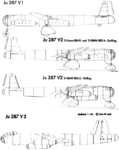Velius
Airman 1st Class
Hello everyone.
Out of all the experimental aircraft of WWII, the Ju-287 fascinates me the most. I have a couple questions regarding this odd bird.
1. Was it the first aircraft with swept forward wings?
2. It was made up of parts from a He-177 (fuselage), B-24 (nosegear), Ju-352(main landing gear), and Ju-388 (tail assy.). Were there other planes in history (any era) built from different aircraft components?
3. The V2 variant (if I am not mistaken) was built and powered by 6 BMW 003A turbojets arranged in clusters of three under each wing! Could this have been the first aircraft powered by 6 jet engines?
4. What is it's post-war history?
and...
5. What are your personal thoughts/comments about this bird?
Thanks 8)
Out of all the experimental aircraft of WWII, the Ju-287 fascinates me the most. I have a couple questions regarding this odd bird.
1. Was it the first aircraft with swept forward wings?
2. It was made up of parts from a He-177 (fuselage), B-24 (nosegear), Ju-352(main landing gear), and Ju-388 (tail assy.). Were there other planes in history (any era) built from different aircraft components?
3. The V2 variant (if I am not mistaken) was built and powered by 6 BMW 003A turbojets arranged in clusters of three under each wing! Could this have been the first aircraft powered by 6 jet engines?
4. What is it's post-war history?
and...
5. What are your personal thoughts/comments about this bird?
Thanks 8)






